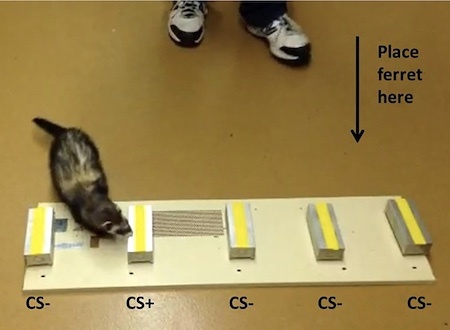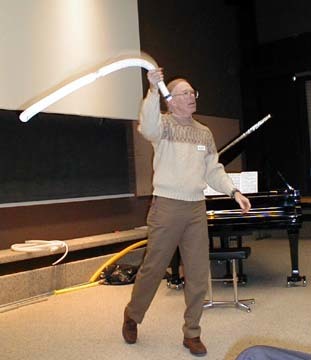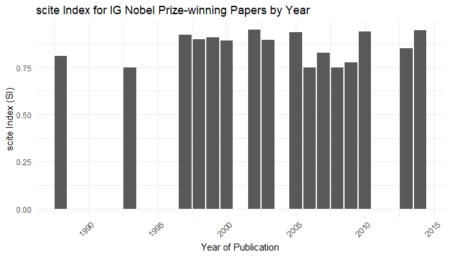Marc Abrahams's Blog, page 76
July 14, 2021
Ig Nobel Prize winner Bolsonaro’s Hiccups: Will He Demand 2006 Winner’s Treatment?
Medical experts are eager to see whether 2021 Ig Nobel Prize winner Jair Bolsonaro, the president of Brazil, will cure his intractable hiccups with the digital-rectal-message treatment devised by 2006 Ig Nobel Prize winner Dr. Francis Fesmire.
Bolsonaro’s ailment is reported in many news outlets. The Dutch newspaper de Volkskrant says, today: “Brazilian President Bolsonaro hospitalized with persistent hiccups—There is a lot of speculation in Brazil as to why President Jair Bolsonaro has had the hiccups for ten days.”
The 2006 Ig Nobel Prize for medicine was awarded to Dr. Francis M. Fesmire, for his medical case report “Termination of Intractable Hiccups with Digital Rectal Massage“; and to Majed Odeh, Harry Bassan, and Arie Oliven, for their subsequent medical case report also titled “Termination of Intractable Hiccups with Digital Rectal Massage.”
President Bolsonaro is himself an Ig Nobel Prize winner.
The 2020 Ig Nobel Prize for medical education was awarded to Jair Bolsonaro of Brazil, Boris Johnson of the United Kingdom, Narendra Modi of India, Andrés Manuel López Obrador of Mexico, Alexander Lukashenko of Belarus, Donald Trump of the USA, Recep Tayyip Erdogan of Turkey, Vladimir Putin of Russia, and Gurbanguly Berdimuhamedow of Turkmenistan, for using the Covid-19 viral pandemic to teach the world that politicians can have a more immediate effect on life and death than scientists and doctors can.

July 13, 2021
Training Ferrets to Recognize Virus Odor in Duck Droppings
The effort to train ferrets to recognize virus odor in mallard duck droppings may be paying off, suggests a new study.
The study is: “Biodetection of a specific odor signature in mallard feces associated with infection by low pathogenic avian influenza A virus,” Glen J. Golden, Meredith J. Grady, Hailey E. McLean, Susan A. Shriner, Airn Hartwig, Richard A. Bowen, and Bruce A. Kimball, PLoS ONE, vol. 16, no. 5, 2021, e251841. The authors report:

“Domesticated male ferrets (Mustela putorius furo) were trained to display a specific conditioned behavior (i.e. active scratch alert) in response to feces from AIV [Avian Influenza Virus]-infected mallards in comparison to feces from healthy ducks….
“A final experiment revealed that trained ferrets could detect AIV infection status even in the presence of samples from mallards inoculated with Newcastle disease virus or infectious laryngotracheitis virus. These results indicate that mammalian biodetectors are capable of discriminating the specific odors emitted from the feces of non-infected versus AIV infected mallards, suggesting that the health status of waterfowl can be evaluated non-invasively for AIV infection via monitoring of volatile fecal metabolites.”

July 12, 2021
nfMRI (non functional MRI) machine resources
 The functional MRI Laboratory at the University of Michigan, US, is one of the few research centres to have their own fully non-functional MRI machine – which they call the “Mock Scanner”.
The functional MRI Laboratory at the University of Michigan, US, is one of the few research centres to have their own fully non-functional MRI machine – which they call the “Mock Scanner”.
The “fake” scanner is fitted with a set of loudspeakers which can faithfully replay the not-inconsiderable noise of a real, working, MRI machine.
For those who might want to book the faux machine for research purposes, details can be found here.
“Currently, there is a lot of time available, so you can book just about any time you want”

July 11, 2021
Podcast Episode #1076: “Adventure of the Random Million Digits”
In Podcast Episode #1076, Robin Abrahams dramatically reads aloud selected highlights from a treasured collection of a million random digits.
Remember, our Patreon donors, on most levels, get access to each podcast episode before it is made public.
Robin Abrahams encounters:
A Million Random Digits with 100,000 Normal Deviates, Rand Corporation, Free Press, 1955
Seth Gliksman, Production Assistant
Bruce Petschek , Producer (Original Recording)
Available on Spotify, Apple Podcasts, Overcast, Google Podcasts, AntennaPod, BeyondPod and elsewhere!

July 8, 2021
Why this year’s Ig Nobel ceremony will be entirely online
People ask us why this year’s (2021) Ig Nobel Prize ceremony will, like last year’s, happen entirely online rather than in the usual big-theater-with-an-audience. Why? Because if you’re organizing a public event, especially an event involving people traveling from many countries, you are aware that this (see news item by Axios, July 8, 2021) kind of thing can happen:

July 7, 2021
Throw Your Paper Airplane Video into the Ig Nobel Ceremony
Would you like to throw a paper airplane, as a visible part of the 31st First Annual Ig Nobel Prize Ceremony? You can! Make a little video, and send it to us.
(Because of the pandemic, this year, like last year, the ceremony is happening entirely online—rather than in its traditional home, Harvard University’s Sanders Theatre.)
Here’s a little video about how you can make a little Ig Nobel paper plane-throwing video:
When?The ceremony webcast will happen on Thursday, September 9, 2021.
We will select the best of the paper airplane videos sent to us. They must arrive here by late July.
Please submit your video to . (If you have questions about it, please ask!)
The History of Paper Airplanes in the CeremonyPaper airplanes have a long and storied history at the Ig Nobel Prize ceremony. As far as we remember, the tradition began at the Second First Annual Ig Nobel Prize ceremony, in 1992, when a large number of MIT students brought paper to the ceremony expressly to make paper airplanes, all of which they then sent on test flights during the ceremony. Hundreds of test flights.
The tradition grew from from that modestly humble start, with more audience members and more paper planes flying high (or low) at every subsequent ceremony.
Sweeping SuccessThe heaps of paper planes accumulating on a stage became a problem that had to be solved. The solution: The ceremony every year includes broom-wielding paper airplane sweepers. That solution itself led to interesting stories. Harvard physics professor Roy Glauber spent a decade sweeping paper airplanes from the Ig Nobel stage, at which point in his career happy fate bestowed an unrelated honor upon him.
A Look Back at Last YearHere’s video of last year’s (2020) Ig Nobel Prize ceremony, the first to happen exclusively online. As you’ll see, paper airplanes, in tiny videos akin to the one that you might make and send to this year’s (2021) ceremony, were prominent:

July 6, 2021
Leroy’s Elusive Little People
A new paper about hallucinations about little people evokes memories (for those who remember) of the fossilized mini-people perceived by Chonosuke Okamura, a discovery that led to Okamura being awarded an Ig Nobel Prize in 1996.
 The new paper is “Leroy’s Elusive Little People: A Systematic Review on Lilliputian Hallucinations,” Jan Dirk Blom [pictured here in quasi-miniature], Neuroscience & Biobehavioral Reviews, epub 2021. The authors, at Parnassia Psychiatric Institute, Leiden University, and the University of Groningen, The Netherlands, explain:
The new paper is “Leroy’s Elusive Little People: A Systematic Review on Lilliputian Hallucinations,” Jan Dirk Blom [pictured here in quasi-miniature], Neuroscience & Biobehavioral Reviews, epub 2021. The authors, at Parnassia Psychiatric Institute, Leiden University, and the University of Groningen, The Netherlands, explain:
“Lilliputian hallucinations concern hallucinated human, animal or fantasy entities of minute size. Having been famously described by the French psychiatrist Raoul Leroy in 1909, who wrote from personal experience, to date they are mentioned almost routinely in textbooks of psychiatry, albeit with little in-depth knowledge. I therefore systematically reviewed 145 case reports and case series comprising 226 case descriptions, concluding that lilliputian hallucinations are visual (61%) or multimodal (39%) in nature. In 97% of the cases, they are perceived as grounded in the actual environment, thus indicating involvement of higher-level regions of the perceptual network subserving the fusion of sensory and hallucinatory content. Perceptual release and deafferentiation are the most likely underlying mechanisms. Etiology is extremely diverse, with schizophrenia spectrum disorder, alcohol use disorder and loss of vision accounting for 50% of the cases and neurological disease for 36%. Recovery was obtained in 62% of the cases, whereas 18% of the cases ended in chronicity and 8% in death.”

July 5, 2021
All You Need to Know About Whirly Tubes
 If you’re interested in the music of Whirly Tubes, and the physics behind it, the late Dr. Paul Doherty’s website may be just the thing for you. There you will find (amongst many other things) sections on :
If you’re interested in the music of Whirly Tubes, and the physics behind it, the late Dr. Paul Doherty’s website may be just the thing for you. There you will find (amongst many other things) sections on :
What Notes Do Whirlies Sing?
What makes a whirly sing?
Math Root the connection between the frequency of the note and the frequency of rotation.
The Speed of Airflow Inside the Whirly

July 4, 2021
Podcast Episode #1075: “The Rheology of Cats”
In this Podcast Episode #1075, Marc Abrahams shows some unfamiliar research studies to fluid dynamicist Nicole Sharp. Dramatic readings and reactions ensue.
Remember, our Patreon donors, on most levels, get access to each podcast episode before it is made public.
Nicole Sharp encounters:
“On the Rheology of Cats,” Marc-Antoine Fardin, Rheology Bulletin, vol. 83, 2, July 2014, pp. 16-17 and 30.
Seth Gliksman, Production Assistant
Available on Spotify, Apple Podcasts, Overcast, Google Podcasts, AntennaPod, BeyondPod and elsewhere!

July 1, 2021
“How are Ig Nobel Prize-Winning Papers Cited?”
A paper, published in Medium, tries “to analyze how Ig Nobel Prize-Winning papers are supported or disputed in later research.”

Marc Abrahams's Blog
- Marc Abrahams's profile
- 14 followers






